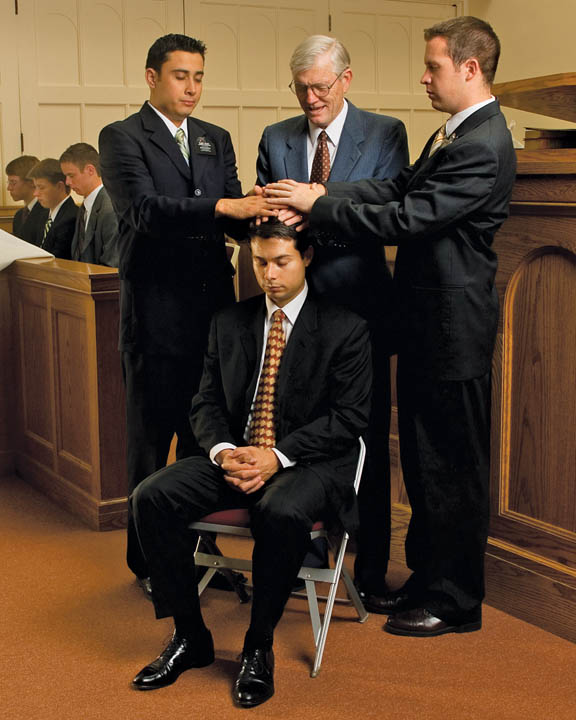Difference between revisions of "Laying on of Hands"
m (Reverted edits by RonorOlget (Talk); changed back to last version by Gboyd) |
Dennisangot (talk | contribs) |
||
| (5 intermediate revisions by 5 users not shown) | |||
| Line 1: | Line 1: | ||
| − | In Christ's Church, those who have the proper [[priesthood]] authority lay their hands on the head of the person receiving an [[Ordinances|ordinance]] or blessing. This act has always been used as a way to invoke the power of God. Genesis 48:14 states, “Israel stretched out his right hand, and laid it upon Ephraim’s head,” to give him a blessing. Peter and John bestowed the gift of the Holy Ghost in this same manner, “Then laid they their hands on them, and they received the Holy Ghost” (see Acts 8:17). | + | [[image: Mormon Gift Holy Ghost.jpg|300px|right|alt=Mormon Confirmation and Gift of the Holy Ghost|Mormon Confirmation and Gift of the Holy Ghost]]In Christ's Church, those who have the proper [[priesthood]] authority lay their hands on the head of the person receiving an [[Ordinances|ordinance]] or blessing. This act has always been used as a way to invoke the power of God. Genesis 48:14 states, “Israel stretched out his right hand, and laid it upon Ephraim’s head,” to give him a blessing. Peter and John bestowed the gift of the Holy Ghost in this same manner, “Then laid they their hands on them, and they received the Holy Ghost” (see Acts 8:17). |
Following this same procedure, members of [[The Church of Jesus Christ of Latter-day Saints]] perform priesthood ordinances by the laying on of hands, and it is a vital part of LDS doctrine. The [[Articles of Faith]], which explain some of the most basic tenets of LDS doctrine state, | Following this same procedure, members of [[The Church of Jesus Christ of Latter-day Saints]] perform priesthood ordinances by the laying on of hands, and it is a vital part of LDS doctrine. The [[Articles of Faith]], which explain some of the most basic tenets of LDS doctrine state, | ||
| Line 18: | Line 18: | ||
See also the LDS [http://scriptures.lds.org/gsh/hndslyng Guide to the Scriptures] | See also the LDS [http://scriptures.lds.org/gsh/hndslyng Guide to the Scriptures] | ||
[[Category:Priesthood]] | [[Category:Priesthood]] | ||
| + | [[de:Hände auflegen]] | ||
| + | [[es:Imposición de Manos]] | ||
| + | [[ru:Возложение рук]] | ||
Latest revision as of 08:28, 22 September 2010
In Christ's Church, those who have the proper priesthood authority lay their hands on the head of the person receiving an ordinance or blessing. This act has always been used as a way to invoke the power of God. Genesis 48:14 states, “Israel stretched out his right hand, and laid it upon Ephraim’s head,” to give him a blessing. Peter and John bestowed the gift of the Holy Ghost in this same manner, “Then laid they their hands on them, and they received the Holy Ghost” (see Acts 8:17).Following this same procedure, members of The Church of Jesus Christ of Latter-day Saints perform priesthood ordinances by the laying on of hands, and it is a vital part of LDS doctrine. The Articles of Faith, which explain some of the most basic tenets of LDS doctrine state,
- We believe that the first principles and ordinances of the Gospel are: first, Faith in the Lord Jesus Christ; second, Repentance; third, Baptism by immersion for the remission of sins; fourth, Laying on of hands for the gift of the Holy Ghost.
- We believe that a man must be called of God, by prophecy, and by the laying on of hands by those who are in authority, to preach the Gospel and administer in the ordinances thereof.
Some of these ordinances are:
- Confirmation
- Ordination
- Blessing the sick
- Setting members apart to serve in callings
- Other priesthood blessings such as Father’s blessings and Patriarchal blessings.
To have the authority to perform this act of laying on of hands, male members of the Church must receive this authority by the laying on of hands from a priesthood holder who has the proper authority. Proper authority has been passed down in the Church from the Apostles Peter, James and John, who received their authority from Christ. These Apostles then visited Joseph Smith as angelic messengers and gave him the proper priesthood authority. From Joseph Smith the priesthood has been passed down in an unbroken line from Christ.
Having the authority of the priesthood is different from having the power to use that priesthood. LDS doctrine teaches that to be able to use the power of the priesthood the person must be worthy of it. H. Burke Peterson, a leader in the Church said,
- All of us who hold the priesthood have the authority to act for the Lord, but the effectiveness of our authority—or if you please, the power that comes through that authority—depends on the pattern of our lives; it depends on our righteousness (H. Burke Peterson, “Priesthood—Authority and Power,” Ensign, May 1976, 32).
See also the LDS Guide to the Scriptures
